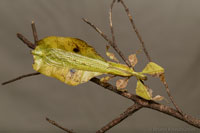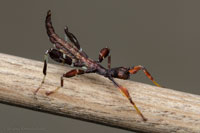Avoiding parthenogenetic cultures
Parthenogenetic cultures are less interesting (behavioural variety, taxonomical value) and sometimes even of lesser vitality (reduced hatching ratio, weaker individuals). Responsible-minded breeders thus strive to maintain sexual cultures. Here some advice on how to avoid parthenogenetic Phyllium cultures.

A general advice to begin with, if your Phyllium culture has gone parthenogenetic, then better start again with a new batch of fertilized eggs, gotten from a reliable breeder.
male / female ratio
Breeders tend to put several (sometimes even many) females with only a few or (in the worst case) with even just one male. But older Phylllium males (especially of the subtaxon Pulchriphyllium) are not particularly active when it comes to mating. If there are more females than males in the cage, then there is a good chance that some females won't be fertilized, which will lay parthenogenetic eggs only. Fertilized and parthenogenetic eggs look just the same and can't be distinguished, thus some of the eggs the breeder will put aside for his next generation (or which he distributes to other breeders) will be non-fertilized, parthenogenetic eggs. With the result that in the next generation males could be scarce, and the culture could become parthenogenetic quickly
Therefore, to be on the safe side, do not put more females than males in the same cage. Even better, have more males than females. Our goal should always be to have a healthy culture with fertilized eggs. Never should we strive to "produce" as many eggs as possible at the danger of our culture becoming parthenogenetic. And obviously parthenogenetic eggs shall not be distributed, as long as other sexual cultures of the same population exist. That would be cheating.
Males mature (and die) way before females do
As phasmid males have one moult less than females, Phyllium males tend to be adult before the females are. This is especially true for Pulchriphyllium species and the Ph. westwoodii species group. Therefore there is some chance that the males will die before the females mature, with the result of a parthenogenetic culture. Here some easy steps how to avoid this:
- Sex Phyllium nymphs as soon as possible. In L2 or L3 it is quite easy to see the difference between male and female nymphs
- keep male nymphs at a lower temperature (e.g. 18 - 20°C) than the female nymphs
- This might be a bit difficult to accomplish during summer time. But the rest of the year for example one can put the cage with the males on the room floor and the cage with the female nymphs on a top shelf. There will be a temperature difference of several degrees. Or one has another room with lower temperatures
- one can also incubate some freshly laid eggs at a lower temperature (e.g. 15 - 16°C) for about 1 - 2 months. This will increase the overall incubation time, and greatly increase the chance to have adults males ready at the right time. Please not that this should be done with freshly laid eggs, not with eggs which are close to hatching
- Collect eggs for incubation over a period of several weeks or better months, then the next generation will naturally have male and female nymphs of different age
- Freshly adult males can be kept at a lower temperature (like around 18°C) too, in order to keep them alive for a longer time
- And it is not uncommon that from the very same batch of eggs, some nymphs hatch a long time (even many months) after the first nymphs have hatched. So do not give up on the unhatched eggs
- If one of your Phyllium cultures turns parthenogenetic, then the best thing to do is that you get yourself fresh eggs of a sexual culture and start all over. And get rid of the old parthenogenetic culture. Attempting to get a male from another breeder for your lonely female is only the second best choice - as you won't know how old the male will be
Longevity of males
There is a widespread misconception that Phyllium males are generally very short-lived. Yet in all the Phyllium cultures we have kept so far (even for Phyllium giganteum "Tapah") we found that males easily live for 2 - 3 months, or even longer. Just keep them in a cage a slightly increased humidity (≥ 80% RH). Yet it is true that older males tend to be less active sexually.
If Phyllium males die too quickly all the time, then something is off with the culture conditions.

"Behavioural Cannibalism"
Phyllium species are prone to what can called "behavioural cannibalism", where they mistake eachother for (food plant) leaves. As an example, the photo below shows two Phyllium sp. "Bukit Daun, blue coxae" females. This is a culture which is very prone to this behaviour. The female on the left is badly affected, while the one on the left is almost unscathed.

This kind of damage is not often seen on images of wild-caught specimens. Which implies that this is due to the breeding conditions. Most probably this is just an accidental behaviour, which happens when there are too many specimens in the same cage (overpopulation) and /or not enough food plants. Usually it is just the females which are affected by this (potentially damaging) behaviour, while the males are usually unscathed. As the (mating) males are often on the back of the females, thus it could be that the males are often the culprits. This could happen during mating (when they are coupled up with the female), during which they find it difficult to reach the "real" leaves. So it could be more convenient for them to start feeding on what first meets their mouth - the female's abdomen.
In our experience, spraying the cage with adult Phyllium a bit more often (like 3 - 4 times a week) than the nymph's cage, seems to reducing the extent of this behaviour a bit. But make sure that the cage is well ventilated and the sprayed water will dry up within a few hours
Species which are prone to this behaviour are for example Phyllium sp. "Bukit Daun, blue coxae", Phyllium jacobsoni "Halimun", Phyllium westwoodii "Tha Pla Duk", Phyllium giganteum "Tapah", Phyllium ericoriai "Jbong Sapa". And there are species on the other hand, where this behaviour is rarely observed, for example Phyllium rubrum "Tapah" or Phyllium letiranti "Tataba").
As long as these "cannibalistic" injuries are not too severe, the affected specimens will survive easily. It seems as if this does not affect vital organs badly. Yet even though this might often not be a very serious injury, we should try our best to avoid this by keeping Phyllium in a spacious cage with a lot of food plants. Out in nature, the population density is never as high as it is in our cages! And this "cannibalilstic" behaviour in crowded cages is yet another good reason why we keep just one species per cage. All the more, as we wanna keep cultures pure, all the more as we do not know how easily different Phyllium species hybridize. With several different cultures / species being presend in one and the same cage, overpopulation (and thus "behavioural cannibalism") is inevitable.
Another possibility to reduce "behavioural cannibalism" is to keep males in a seperate cage And to bring males and females together for some days at regular inverval (e.g. every two weeks or so).
What to begin with - eggs or nymphs / adults?
Regularely we hear that phasmids do not really thrive well or even die quickly, when they are passed from one breeder to another. A possible explanation for this is, that older nymphs / adults become quite adapted (not to say "addicted") to the micro-climatic conditions they are exposed to. And this seems to lead to acclimatization problems when a breeder offers his phasmids to another breeder, as most probably the micro-climatic conditions will be different at their new home. Thus our recommondation clearly is to begin with eggs, as young nymph's propensities / capability to cope with various micro-climatic conditions is better than that of older nymphs or even adults.
Also it is not really a good idea to ship spare males around the world, unless it is the only way left to save a culture from becoming parthenogenetic. First of all this is a great stress for them (have you ever seen how they treat parcels at the post office....?), and then you have no idea who old the male actually is. So better to start off again with a new batch of eggs from a reliable breeder
Some further recommendations

- Do not incubate Phyllium eggs too moist, they are quite prone to get mouldy. A medium humidity is good enough (as explained in the Cup-Incubation Method), even for moistness-loving species like Haaniella
- Phyllium eggs (as well as eggs of many other phasmid species) even hatch very well if kept on a dry substratum while being exposed to a humidity of about 65 - 70 % RH
- The Cup-Incubation-method works perfectly for Phyllium
- So far nymphs of all Phyllium species we have bred hatched during daytime. Usually they hatch some hours after sunrise (or after the lights have been turned on in the phasmid room) until around noon
- Therefore a near-natural incubation setup shall include a daily day-night (light-darkness) change
- Do not move the incubation container in the early morning hours, so as not to disturb the hatching process
- As they are hatching in broad daylight, and not under the screen of night, it makes sense that they are blackish-brown upon hatching and not yet green. A blackish-brown little nymph climbing out of the leaf litter on the forest floor and running up a barky tree trunk is much better camouflaged than a green one
- It can take up to several days (even up to one week) before freshly hatched nymphs start to feed (for example Phyllium giganteum "Tapah"). This survival skill is very essential out in nature. They hatch from eggs which often lay on the forest floor, as their mothers just fling the eggs away with a sway of their abdomen. And their food plants are up in the forest canopy.... So it can be a long search before they find their food plant
- Young Phyllium nymphs are mainly day-active, and they rest insitu during the night. On the other hand, older nymphs and adults are both day and night active
- Phyllium have a tendency to go up ... up ... up. Thus they often prefer the uppermost food plant leaves in the cage, while not touching the leaves in the middle or even lower part of the cage. To accommodate this behaviour, it is best to arrange the food plants in the upper part of the cage, with the leaves close to the cage walls and ceiling (so that they can find them). This also helps to minimize that they feed on each other.
- Older nymphs and adults do also well in a cage with lesser ventilation, even though the nymphs have been kept in a (drier) netting cage
- Both nymphs and adults benefit when there is a ventilator running, (for example) at regular intervals of 15 minutes on / 15 minutes off throughout the day
- Keep all Phyllium cultures strictly separate and pure at all stages of their development, in order to avoid hybridization